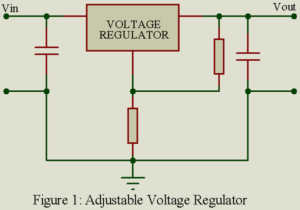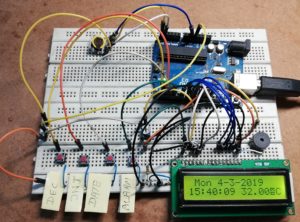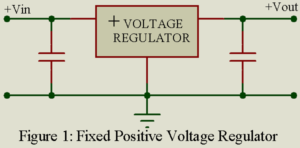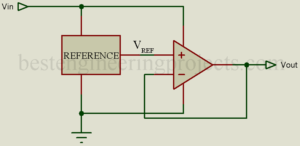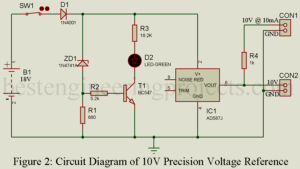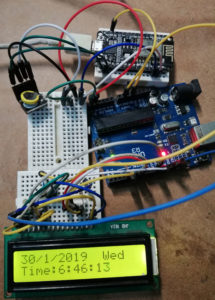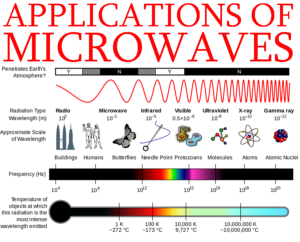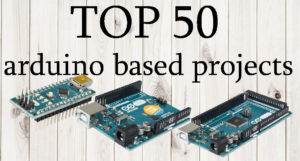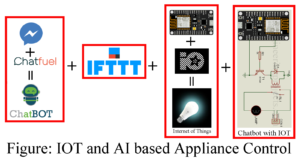The basic circuit of Adjustable Output Voltage Regulator is essentially the same as for fixed output voltage regulators, but there is provision for an external resistive divider or potentiometer to adjust the output voltage. Positive or negative polarity output voltage can be obtained by the same type of connections described in Fixed Output Voltage Regulator. Most of the adjustable type voltage regulators also contain one or more protective features such as over-voltage and over-temperature shutdown. Manufacturers data contain specific resistance values and/or potentiometer connections to provide the desired output voltage…
Read MoreArduino Alarm Clock with Time Setting
In the post-Arduino alarm clock with time setting you will learn to make a digital clock using the RTC DS3231 module with alarm and temperature indication facility. Previously, we had already posted various types of clock circuits using Arduino and RTC DS3231 like “Arduino NTP Clock using NodeMCU and DS3231”, “Arduino Digital Clock using DS3231 Pi Module“. Before starting to circuit part and software code part let’s see its features: Features of Arduino alarm clock with time setting Display date and time (day and second indication). Alarm time setting Display…
Read MoreFixed Output Voltage Regulator
This basic three-terminal device Fixed Output Voltage Regulator is available as either a positive or negative voltage regulator for a large range of fixed output voltages. In figure 1 small capacitor are shown at the input and output of the voltage regulator, because in many applications such capacitors are required to assure stable operation. Ordinarily we can obtain voltage regulators of the required polarity but it is also possible, as illustrated in figure 2, to use a negative voltage regulator to provide a regulated positive output voltage.Similar connection can be…
Read MoreVoltage Regulator Description and Application
Voltage Regulator Description: IC Voltage regulators operates basically in the same manner as discrete circuit regulators. As illustrated in figure 1, the input voltage, usually the rectified ad filtered power-supply output, is applied to the reference circuit and to the op-amp. For optimum regulation, the op-amp must have high open-loop gain and a fairly large common-mode rejection ratio (CMMR). The reference source determines the accuracy of the regulated voltage output. Reference voltages can be provided by such simple device as a zener diode or by more complex multi-transistor circuits, such…
Read MorePrecision Voltage Reference Circuit
A precision voltage reference provides a constant, stable output voltage under a wide range of line, load, and temperature conditions. These devices usually work on the principle of bandgap voltage. Voltage drops are produced across two transistor base emitter diodes with unequal current flow. These voltage drops exhibit a negative temperature coefficient (the drop decreases as temperature is increased). However, the difference between the two voltage drops exhibits a positive temperature coefficient. When properly combined to equal a sum of 1.23V (the bandgap voltage), a near zero temperature coefficient is…
Read MoreArduino MOSFET LED Driver Circuit
In the tutorial Arduino MOSFET LED driver circuit, you will learn to make your MOSFET Driver for any higher power appliance like LED Strip, high power DC motor, etc. We all know that we need a driver circuit to control high-power appliances like DC motors, electrical appliances, etc. So, here we are using MOSFET to control the operation of the LED strip. If you want to know more about MOSFET, its type, Symbol, application, and characteristic curve please do read the previous article on MOSFET | Types of MOSFET |…
Read MoreArduino NTP Clock using NodeMCU and DS3231
In the tutorial Arduino NTP Clock using NodeMCU and DS3231, you will learn to make an accurate clock using the RTC module and NTP server. This circuit automatically updates the time of the RTC module from the network time protocol server. RTC module shows some time delay after some days/week, this is due to temperatures dependent oscillator used in this module. The external oscillator is more prone to temperature than an internal oscillator. DS3231 module has an internal oscillator that is less prone to temperature and humidity but still has…
Read MoreWhat are the Applications of microwaves
The are various applications of microwaves or we can say the application of microwaves can be broadly classified because of their use in various fields including cooking, long ranger communications, etc. The foundation of modern electronics and communications environment using radio frequency (RF) and microwaves were laid in the nineteenth century, named after Michael Faraday’s observations of magnetic field on light propagation in 1845, and James C Maxwell’s derivation of four basic equations of the electromagnetic theory of light. Because of the short physical wavelength of these frequencies, they present…
Read MoreTop 50 Arduino Based Projects
Top 50 Arduino Based Projects: The popularity of Arduino Platform is at most because of its user friendly interface, easy to program, cheap, small size. For electronic hobbyist arduino platform become dream come true due to its plug and play option. Thus, we are going to compile Top 50 Arduino Based Projects posted in bestengineeringprojects.com. This project list include all those popular arduino based project posted in this website. The impact of arduino platform is felt not only in all branch science and engineering but in the life of ordinary…
Read MoreAppliance Control using IOT and AI Chatbot
IoT (Internet of thing) is one of the burning topics among electronic hobbyists and students due to its various advantage. There are many ways/devices with which you can interface your appliance with the internet, NODE MCU is one of them. Node MCU is very much popular due to its various advantage. Some of them are listed below. Thus we are going to make Appliance Control using IoT and AI Chatbot using NodeMCU. Smaller size and breadboard friendly Hardware and pinout are more like Arduino. Support API in Nodejs style thus…
Read More